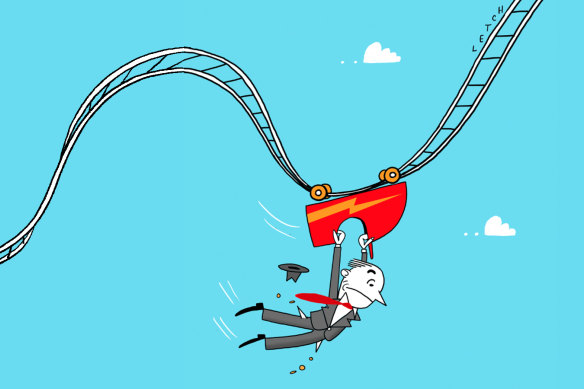What can you do to accelerate your wealth creation? The most obvious suggestions are the most basic ones: spend less and save more, chase a new higher-paying job, and ensure any surplus cash is invested. But I’m going to assume that you’ve done all that.
I’m also going to assume that you have a time horizon of at least 10 years. If your time frame is less than this, then it’s likely the strategies here involve more risk than would be sensible for you.
To supercharge your wealth creation, you need to be prepared to take on more risk.Credit: Simon Letch
If your money earns 5 per cent, then your savings will double in value in a little over 14 years. If you can push this earnings rate up to 9 per cent, your money will take eight years to double.
Lifting your earnings rate is the key to accelerating your wealth creation, but – as we know – there’s no such thing as a free lunch. An investment that earns 9 per cent will be riskier than an alternative investment paying 5 per cent.
To supercharge your wealth creation, you need to be prepared to take on more risk. Nothing crazy – I’m certainly not suggesting you mortgage the house and put it into crypto or cannabis stocks – but the level of risk in your portfolio can be raised prudently if you have an appropriate investment timeframe and appropriate contingency plans.
With that in mind, let’s consider three ways you could turn up the risk dial.
1. Discard defensive assets from your investment holdings
Defensive assets are cash and bonds. Whilst bonds have had a pretty terrible past 18 months, generally speaking, these defensive assets provide stability in your portfolio. But this stability comes at a cost: lower overall returns.
Some numbers from researcher Lonsec found that a typical balanced fund, which is a fund that has 40 per cent of its allocation in defensive assets, has earned an average return of 6.9 per cent since the beginning of this century. In comparison, a portfolio with no defensive assets has earned on average 8.1 per cent, per year.
But, as mentioned, there’s no such thing as a free lunch. The balanced investor had to tolerate a drop in their portfolio value of just under 20 per cent in the worst 12-month period of this time frame. The 100 per cent growth investor, however, saw their portfolio drop by 35 per cent in that time.
2. Leverage
The next way to ratchet up your risk is to add leverage via borrowing. Many Australians have built wealth through property investment, however, when you look at the investment in isolation it’s often not a stunning success. Properties constantly need maintenance and the rent barely covers the holding costs.
But the secret to property success is the ease with which it can be leveraged. For just a small deposit you can have exposure to an asset worth hundreds of thousands of dollars if not millions. In fact, those with equity in their home might be able to pay no deposit at all to gain this exposure.
If you put a $100,000 deposit down on a $1,000,000 property and sometime later that property increases in value by 10 per cent, then very simplistically your initial investment just doubled in value.
You borrowed $900,000 at the outset, and when you sold the property for $1.1 million you paid that loan back, leaving $200,000 in your pocket. This is greatly simplified, but it illustrates perfectly the power of leverage.
3. Bias to US shares and small caps
My third suggestion is based on historical return data. None of us know what the future will bring, and you know the normal caveats about past returns not being indicative of future returns. So keep that in mind while I talk you through this third idea.
A final way to get more aggressive with your portfolio would be to bias it towards US shares and small caps. By necessity, this means having less exposure to large-cap Australian shares. The small caps bias could be both Australian and global.
Over the past 30 years, US shares have delivered returns almost 2 per cent a year better than Australian shares on average. Now perhaps this won’t be repeated in the coming decades, but it’s tough to see what change has occurred that would alter this playing field.
A bias toward small caps seeks to address the low growth tendency of Australian large-cap stocks. On average, small-cap stocks have produced greater returns than large caps. In the global space, small-cap stocks have produced on average a 2.3 per cent greater return than the large cap biased global equities index.
- Advice given in this article is general in nature and is not intended to influence readers’ decisions about investing or financial products. They should always seek their own professional advice that takes into account their own personal circumstances before making any financial decisions.
Paul Benson is a Certified Financial Planner, and host of the Financial Autonomy podcast.
The Market Recap newsletter is a wrap of the day’s trading. Get it each weekday afternoon.
Most Viewed in Money
From our partners
Source: Read Full Article

